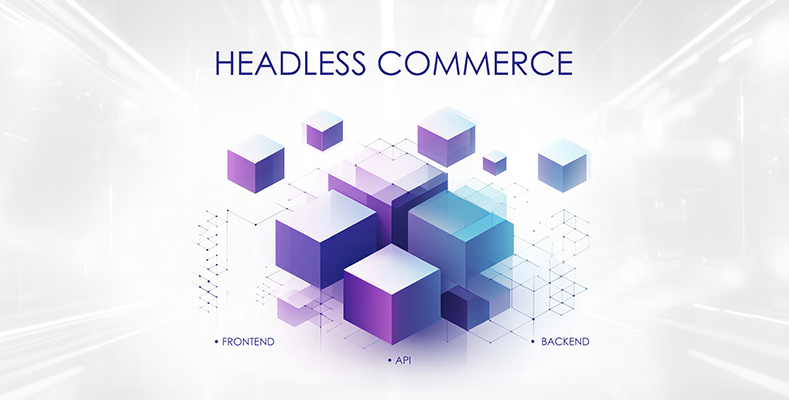Subtotal $0.00
Headless commerce is a modern approach to e-commerce architecture where the front-end (the part of the website or app that users interact with) is decoupled from the back-end (where business logic, data storage, and processing occur). This separation allows businesses to deliver content and products through various channels (like websites, apps, social media, IoT devices) independently of the back-end systems.
Traditional e-commerce platforms were monolithic, i.e. the front-end and back-end were tightly coupled. Any change to the user interface would require changes to the back-end, making it difficult to adapt to new technologies and user expectations. As digital channels expanded (mobile, social media, voice assistants), businesses began using APIs (application programming interfaces) to allow their back-end systems to interact with different front-ends. This led to a more flexible architecture.
The demand for personalized, omnichannel experiences drove the evolution of e-commerce to headless models. This architecture uses APIs to connect a back-end e-commerce platform with any front-end technology, giving businesses the flexibility to design unique user experiences across multiple channels without being restricted by the limitations of a traditional platform.
Benefits:
-
Flexibility and customization: Businesses can create highly customized front-end experiences without being restricted by the back-end platform. This allows for more creative freedom and the ability to innovate with new technologies.
-
Faster time to market: Since the front-end and back-end are decoupled, changes can be made to the user interface or add new sales channels quickly without waiting for back-end modifications.
-
Omnichannel experiences: Headless commerce allows businesses to provide a consistent and seamless experience across various channels, including web, mobile, social media, and internet of things (IoT) devices.
-
Scalability: As businesses grow and their needs evolve, headless commerce platforms can easily scale to accommodate new technologies, user demands, and market trends without requiring a complete overhaul of the system.
-
Improved performance: By offloading the front-end to a separate environment, websites can be optimized for faster loading times and better user experiences, which is crucial for conversion rates.
In the 21st century, the rise of digital transformation and the proliferation of digital touchpoints have driven the adoption of headless commerce. Consumers now expect personalized, seamless, and instant shopping experiences across multiple channels, making headless commerce increasingly relevant.
Companies are adopting this model to stay competitive by offering more dynamic and engaging user experiences. The rise of microservices architecture, where different parts of an application are developed and maintained independently, also complements the headless commerce approach, making it easier to integrate various tools and services.
As businesses continue to focus on creating customer-centric experiences and expanding their reach across various digital platforms, headless commerce is becoming a preferred architecture for many modern enterprises. Its ability to future-proof e-commerce operations and provide the agility needed in a rapidly changing digital landscape is a significant factor driving its growth.
Many companies across various industries have adopted headless commerce to enhance their digital presence and provide seamless, omnichannel experiences. Some of them include:
1. Nike: Sportswear and Footwear
Nike uses a headless commerce architecture to deliver personalized and fast shopping experiences across multiple digital channels.
2. Target: Retail
Leverages to create a unified shopping experience across its website, mobile apps, and physical stores.
3. Amazon: E-commerce
To deliver content and products across various platforms, including its website, mobile apps, voice assistants like Alexa, and more.
4. Lululemon: Apparel and Accessories
To integrate its digital and physical shopping experiences, providing customers with seamless interactions whether they’re online or in-store.
5. Tesla: Automotive
Tesla’s online presence is built using a headless commerce model, allowing for a highly customized and interactive experience for users who are configuring and purchasing vehicles online.
6. Best Buy: Electronics Retail
To manage its vast inventory and provide real-time updates and consistent experiences across its website, mobile apps, and in-store kiosks.
7. Red Bull: Beverage
To deliver content and products across various digital touchpoints, including websites, apps, and social media platforms, enhancing their global brand presence.
8. Walmart: Retail
Uses this approach to provide seamless and fast shopping experiences, particularly in its mobile apps and online grocery services.
9. McDonald’s: Fast Food
To power its digital ordering systems, including mobile apps and self-service kiosks.
10. IKEA: Furniture Retail
Integrates its online and offline experiences, allowing customers to interact with the brand across multiple channels.
These companies leverage headless commerce to provide a more responsive, flexible, and consistent experience to their customers, helping them stay competitive in the fast-evolving digital landscape.



